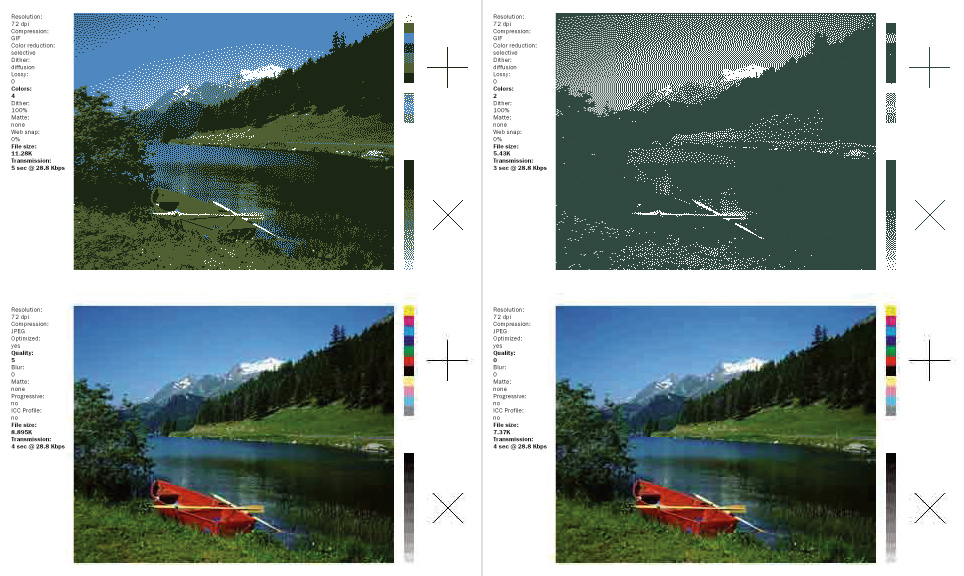



- 2005
- offset lithograph
- 175 x 235 mm, 8 pp
nature.gif/nature.jpg
Following is a text that accompanied the work:
Digital image compression technology is essential to the ecology of the internet: images must be compressed somehow simply to exist in its (still) lean environment. Most likely, an image would be either GIF- or JPEG-formatted, PNG being less common despite its many advantages. Both GIF and JPEG are “lossy” systems, meaning the quality of an image must be compromised in order to achieve optimal file size.
GIF, Graphics Interchange Format, was developed in 1987 by CompuServe specifically for its network services. Since then, it has been one of the most popular compression methods due to its flexibility – depending on the nature of the original image, it can reduce the file size almost to nothing – as well as its simple animation capacity. Whatever the actual algorithm of GIF is, its most visible effect is color reduction: a GIF image can only display up to 256 colors. The fewer the colors that are used, the smaller the file size becomes.
The other popular compression technology, JPEG, derived its name from its original developers, Joint Photographic Experts Group. As the name suggests, JPEG is widely used to compress photographic images (GIF is more suitable for line drawings or simple graphics that use a limited number of colors), and, naturally, most digital cameras support JPEG format. A fine-quality JPEG image may not show any noticeable difference from the original, but when highly compressed, it may reveal some “artifacts” (blemishes), compromising clarity.
How many JPEG’s and GIF’s can you expect to actually see on the internet? If you try Google Images with the keyword “JPEG,” it will give you about 8,710,000 results. Try “JPG,” then you’ll get 11,800,000 more: at least twenty million JPEG’s on the internet, then. (The actual number might as well be ten times more than that.) And about 12,100,000 GIF images could be found on Google. Google’s logo itself is always a GIF image, except, perhaps, on its error page. There, a text-only version of the logo, simply set in Times New Roman Bold, replaces the usual drop-shadowed semi-3D graphic logo, as if to imply that non-graphic, text-only presentation is rather abnormal on the internet.
Most certainly, you can download any JPEG or GIF image you see on the internet. So, if you really don’t have anything better to do, then it might be worthwhile to start a collection of compressed images. It can be organized by algorithm, by size, or by whatever categories you like. Shouldn’t we be careful about those apparently harmless pictures, though? A digital image may contain hidden messages from a terrorist organization. Rumor has it that the technique known as “steganography” has been widely used by Al-Qaeda to hide its secret instructions in (among other types of images) pornographic JPEG images on the internet. Then, finally, images have become actually dangerous: a grotesque realization of the avant-garde dream.
- Project type:
- publication
- Typeface:
- Franklin Gothic
- Commissioner:
- Arts Council Korea
- Published in:
- Bol, no. 1